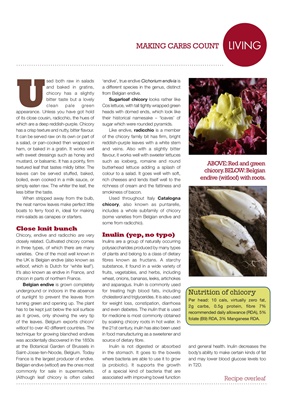
KITLIVING
Used both raw in salads
and baked in gratins,
chicory has a slightly
bitter taste but a lovely
clean pale green
appearance. Unless you have got hold
of its close cousin, radicchio, the hues of
which are a deep reddish-purple. Chicory
has a crisp texture and nutty, bitter flavour.
It can be served raw on its own or part of
a salad, or pan-cooked then wrapped in
ham, or baked in a gratin. It works well
with sweet dressings such as honey and
mustard, or balsamic. It has a pointy, firm
textured leaf that tastes mildly bitter. The
leaves can be served stuffed, baked,
boiled, even cooked in a milk sauce, or
simply eaten raw. The whiter the leaf, the
less bitter the taste.
When stripped away from the bulb,
the neat narrow leaves make perfect little
boats to ferry food in, ideal for making
mini-salads as canapes or starters.
Close knit bunch
Chicory, endive and radicchio are very
closely related. Cultivated chicory comes
in three types, of which there are many
varieties. One of the most well known in
the UK is Belgian endive (also known as
witloof, which is Dutch for 'white leaf').
It's also known as endive in France, and
chicon in parts of northern France.
Belgian endive is grown completely
underground or indoors in the absence
of sunlight to prevent the leaves from
turning green and opening up. The plant
has to be kept just below the soil surface
as it grows, only showing the very tip
of the leaves. Belgium exports chicon/
witloof to over 40 different countries. The
technique for growing blanched endives
was accidentally discovered in the 1850s
at the Botanical Garden of Brussels in
Saint-Josse-ten-Noode, Belgium. Today
France is the largest producer of endive.
Belgian endive (witloof) are the ones most
commonly for sale in supermarkets.
(Although leaf chicory is often called
Per head: 10 cals, virtually zero fat,
2g carbs, 0.5g protein, fibre 7%
recommended daily allowance (RDA), 5%
folate (B9) RDA, 3% Manganese RDA.
Nutrition of chicory
MAKING CARBS COUNT
'endive', true endive Cichorium endivia is
a different species in the genus, distinct
from Belgian endive.
Sugarloaf chicory looks rather like
Cos lettuce, with tall tightly wrapped green
heads with domed ends, which look like
their historical namesake - 'loaves' of
sugar which were rounded pyramids.
Like endive, radicchio is a member
of the chicory family bit has firm, bright
reddish-purple leaves with a white stem
and veins. Also with a slightly bitter
flavour, it works well with sweeter lettuces
such as iceberg, romaine and round
butterhead lettuce adding a splash of
colour to a salad. It goes well with soft,
rich cheeses and lends itself well to the
richness of cream and the fattiness and
smokiness of bacon.
Used throughout Italy Catalogna
chicory, also known as puntarelle,
includes a whole subfamily of chicory
(some varieties from Belgian endive and
some from radicchio).
Inulin (yep, no typo)
Inulins are a group of naturally occurring
polysaccharides produced by many types
of plants and belong to a class of dietary
fibres known as fructans. A starchy
substance, it found in a wide variety of
fruits, vegetables, and herbs, including
wheat, onions, bananas, leeks, artichokes
and asparagus. Inulin is commonly used
for treating high blood fats, including
cholesterol and triglycerides. It is also used
for weight loss, constipation, diarrhoea
and even diabetes. The inulin that is used
for medicine is most commonly obtained
by soaking chicory roots in hot water. In
the 21st century, inulin has also been used
in food manufacturing as a sweetener and
source of dietary fibre.
Inulin is not digested or absorbed
in the stomach. It goes to the bowels
where bacteria are able to use it to grow
(a probiotic). It supports the growth
of a special kind of bacteria that are
associated with improving bowel function
ABOVE: Red and green
chicory. BELOW: Belgian
endive (witloof) with roots.
Recipe overleaf
and general health. Inulin decreases the
body's ability to make certain kinds of fat
and may lower blood glucose levels too
in T2D.